 |
Fort Montgomery
Rouses Point, New York, USA
|
|
 |
Constructed: 1844 - 1871
Used by: United States of America
Designed by: Simon Bernard
Conflicts in which it participated:
None
|
Full disclosure: You'll note that I have cheated just a wee bit with the image above. Much of Fort Montgomery was pulverized into rubble during the Great Depression of the 1930's, so all that's left for the required Starforts.com Main Fort Satellite Image are the southernmost portions of the fort and some of its landward wall, which translate to the right side and bottom of the image above.
|
 |
|
|
I've superimposed an 1872 drawing of the fort atop, so as to give you, the discerning starfort enthusiast, an idea of how it looked when complete. So now that we're all clear that there isn't really a ghostly outline of the entire fort floating mystically above the ruins, we can move on. In the days when heavy things couldn't be transported any faster than a stiff wind could blow a ship, lakes and rivers were the world's superhighways. The cities of Montreal and New York were connected by the Richelieu River, Lake Champlain and the Hudson River...which worked just fine in the early days of the continent's colonization, but once everybody remembered that the French and English despised each other, things got more complicated. A combined force of British infantry and navy had descended upon the border town of Plattsburgh, New York in September of 1814, shortly before the end of the War of 1812 (1812-1815). This battle turned out in a disastrous fashion for the British (the American defenses were brilliantly led by Brigadier General Alexander Macomb (1782-1841), who would later have a lovely fort named for him. Fort Macomb was built in 1822 in the interest of defending New Orleans), but nonetheless made quite a mess of Plattsburgh. US troops had been stationed in Plattsburgh since 1812, but anybody who needs to deny passage on a waterway knows they need a strategically sited fort. A starfort, in fact, was what was universally understood to be optimal for such a purpose in the early 19th century...so naturally the US government sent whiz kid Joseph Totten (1788-1864) to build about as ridiculous a non-starfort as anyone could come up with, in 1816. This first American fort on the Richelieu wasn't officially named, but came to be known as Fort Blunder: Not only was it a pretty silly design (octagonal, 30 feet high and built on a weak, crumbly foundation), but upon careful scrutiny after two summers of construction, it was determined that this fort was actually being built inside Canada. By all accounts, the exact location of the border was kind of indistinct, but...good heavens, Mr. Totten. Not that Joseph Totten would have been to blame for this mistake. Regardless, Fort Blunder was abandoned, unfinished and unarmed, in 1818. Enjoy those free building materials, local populace!
|
The Webster-Ashburton Treaty, signed on August 9, 1842, straightened out a number of US/Canadian issues: One of these involved the little island on which Fort Blunder had been built. The border was officially moved three quarters of a mile north, so that the US would be free to build a real fort to defend itself against the wicked British! Doesn't seem to me as though such a decision would have been even slightly in Canada's interest, but then I'm no diplomat.
|
 |
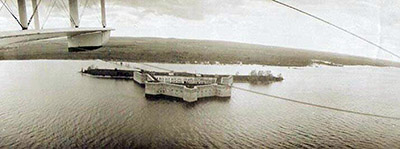 Fort Montgomery in 1922: Still forthright and impressive, prior to being pillaged for the sake of the Rouses Point Bridge in the 1930's. Fort Montgomery in 1922: Still forthright and impressive, prior to being pillaged for the sake of the Rouses Point Bridge in the 1930's. |
|
Simon Bernard (1779-1839), the French military engineer whom starfort enthusiasts will remember as the architect of such Third System US starforts such as Fort Pickens, Fort Adams and Fort Macon (among many others), was asked to design a new fort, and after spending two years deciding for whom a new fort should be named (that honor went to Major General Richard Montgomery (1738-1775) of the Continental Army, who had died leading US troops against the British in Quebec in 1775), the construction of Fort Montgomery finally got underway in 1844. |
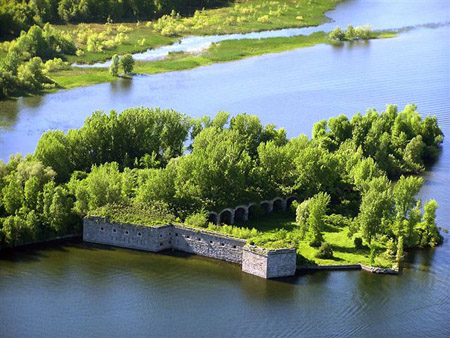 What Fort Montgomery looks like today. If you're above the ground, anyway. What Fort Montgomery looks like today. If you're above the ground, anyway. |
 |
The fort of our current interest was built over a 30-year period, with a particular flurry of activity during the US Civil War (1861-1865), when Federal fears of a British-Confederate alliance reminded everyone of how relatively undefended that northern border really was: Though still under construction, Fort Montgomery was garrisoned by a detachment of the 14th US Infantry for three months in 1862.
A Confederate raid did occur on October 19, 1864, in which banks in the small Vermont town of St. Albans were robbed of over $200,000 by 21 Confederate cavalrymen, who had galloped over the border from Canada. This of course had nothing at all to do with Fort Montgomery, so we will not be |
|
interested to further learn that these raiders returned to Canada, were arrested by the authorities who then judged that these men were combatants, not criminals, and thus released them. Only $88,000 was returned to the banks of St. Albans, and the United States did not immediately invade Canada in retribution as, I think we can all agree, it really should have done.
|
When Fort Montgomery was finally considered complete in 1871, it had walls 48 feet high, gun emplacements for 125 cannon on three levels, and space for a garrison of 800. One of very few US forts to be surrounded by a moat ( Fort Jefferson, Fort Delaware and Fort Monroe are a few others: Read about what may or may not be all of them on the America's Moated Starforts page in this site's Fortnotes section!), Fort Montgomery had an ingenious swiveling drawbridge system that was sure to leave any attacking British, Canadian or Confederate troops scratching their heads in confused immobility. |
 |
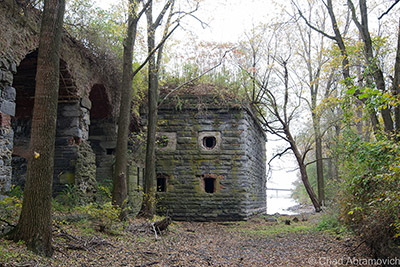 Fort Montgomery in 2014, by Chad Abramovich, from his Obscure Vermont blog. Fort Montgomery in 2014, by Chad Abramovich, from his Obscure Vermont blog. |
|
Other than that three-month period in 1862, however, Fort Montgomery was never even partially garrisoned. The fort was armed to its highest state of defensive pricklyness in 1886, shortly after it was visited by Commanding General of the US Army William Tecumseh Sherman (1820-1891). Sherman was impressed by the state of Fort Montgomery, and thought it silly that no troops were regularly garrisoned there. He of the March to the Sea intended to have the garrison of the nearby Plattsburgh Barracks transferred permanently to the fort, but the resultant outcry of Plattsburgh's prominent local citizens for some reason convinced him otherwise.
|
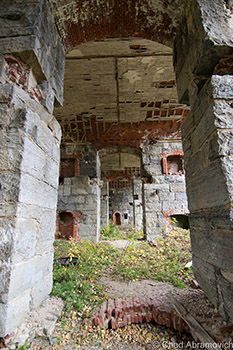 Another great shot by Chad Abramovich: Creepy! Another great shot by Chad Abramovich: Creepy! |
 |
By the end of the 19th century, advancing military technology had eclipsed the concept of the masonry fort, and Canada was showing fewer signs of being the actively bloodthirsty, warlike people that they once were. In 1909 Fort Montgomery's last guns were carted off to Philadelphia to be melted down as scrap metal, and a caretaker sergeant was left to watch over the rotting fort. The US Works Progress Administration's desperate scramble to employ Americans during the Great Depression of the 1930's was Fort Montgomery's ultimate doom. In 1936 the WPA funded most of the cost of the Rouses Point Bridge, which would connect Rouses Point, New York, with Alburgh, Vermont...and be built on a pile of rubble made from most of Fort Montgomery. As needlessly dreadful as this seems now, in the 1930's it made perfect sense: Nobody was using the fort for anything, after all, and it wasn't as though it would ever be called back into service. Plus, let's face facts, we're not talking about an historically important fort here, a Fort McHenry or Fort Ticonderoga or anything. The fact that they were breaking my heart 30 years before I was even born was of no consequence to the hungry folks who needed to feed their families in 1936. And I guess if they had based their decisions on what an unborn person might think 70+ years in the future, they would have been a sorry lot indeed. |
|
Locals had been making an ant trail to and from the fort for decades, relieving it of various windows, doors, plumbing fixtures and whatever else they wanted, but the nail in Fort Montgomery's coffin was the homefront scrap drive program of the Second World War (1939-1945). Iron reinforcing rods, installed at several locations around the fort in 1886 to support spots that would otherwise get wobbly over time, were stripped out of the walls to support the war against the wicked Nazis and arguably equally wicked Japanese. Predictably, one of the fort's three bastions that the WPA had spared collapsed into the moat in 1980.
I've read that those homefront scrap drives, the bain of many a Civil War-era cannon and Fort Montgomery's chance at meaningfully surviving into the 21st century, resulted in very little that materially aided the war effort. The amount of actual metal provided by these scrap drives that was repurposed for fighting America's foes was minuscule, but the program served as a morale-booster on the homefront, to which end it was extremely successful.
|
Today, for the low low price of $2,950,000, what's left of Fort Montgomery could be yours! Efforts have been made over the years to get the fort into somebody's hands who would take care of it and pay for its restoration, or at least prevent it from continuing to collapse into its own moat. Since 2006 the owners have put Fort Montgomery up for sale on eBay on more than one occasion, but as yet it remains the fort that nobody wants.
|
 |
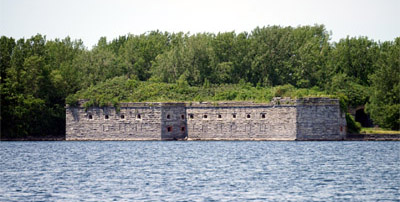 Fort Montgomery's less-impressive visage today. That seems unlikely to dissuade those aggressive Canadians from invading south! Fort Montgomery's less-impressive visage today. That seems unlikely to dissuade those aggressive Canadians from invading south! |
|
In June of 2018 I made an attempt to visit Fort Montgomery whilst on my way to Quebec. I say attempt because it is closed to the public, and I was unable to gain access or even get particularly close to the fort. This is of course as it should be, crumbling starforts are no place for the unwary to trod: Well done, New York State!
Please click on any of the pix below to see their full-sized version, and read about my pseudo-visit to Fort Montgomery.
Fort Montgomery wasn't always as difficult to get into as it is today! A gentlemen by the name of Michael Fay clambered upon our fort in September of 1985, along with his adventurous compatriots Vince, Karen and Doug. "There must not have been any 'no trespassing' signs visible as I would not have done so if I had seen them," reports Mr. Fay. "I apparently didn't take many [pictures](and only one inside) as it wasn't very photogenic inside with most of the walls missing. Plus photos cost a bit more to take and develop in the pre-digital days." Many thanks to Mr. Fay for his selfless generosity in this matter! Below find three of his pix, the clickage of which will result in it's full-sized counterpart opening in a new window, for ease and convenience of study. 
 And speaking of selfless generosity, my sincerest apologies to James P. Millard, webmaster at Historiclakes.org for the slight misuse of his images from the Fort Montgomery section of his site: His images, which I had used on this page, have been removed. In the words of George Harrison in the movie Hard Day's Night when a grumpy gentleman chased the Fab Four from a field on which they had been gleefully (and harmlessly) frolicking for a few minutes: "Sorry we hurt your field, Mister!" |
|
|
|
|
|
 |




